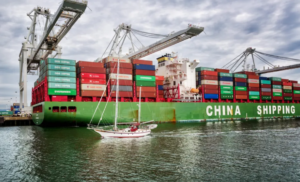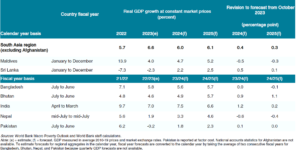South Asia’s Economic Surge Masks Looming Challenges
In a highly anticipated twice-a-year regional outlook, the World Bank reveals a staggering growth projection for South Asia, soaring to an impressive 6.0% in 2024-25. This meteoric rise is primarily propelled by India’s robust expansion and the remarkable recoveries witnessed in both Pakistan and Sri Lanka. However, amidst this promising outlook, the World Bank’s latest South Asia Development April Update, coined “Jobs for Resilience,” exposes a grim reality overshadowing the region’s economic surge.

Despite maintaining its status as the fastest-growing region globally for the next two years, with growth forecasted at an astounding 6.1% in 2025, the report unveils unsettling truths. While public spending continues to buoy growth, private investment across all South Asian nations has plummeted significantly. Moreover, the region grapples with a critical employment crisis, failing to generate adequate job opportunities to accommodate its rapidly expanding working-age population.
Martin Raiser, the World Bank Vice President for South Asia, issues a stark warning, cautioning that the region’s flourishing growth trajectory is threatened by precarious fiscal positions and escalating climate shocks. Urgent policy interventions are imperative to fortify growth resilience, with a pressing need to stimulate private investment and bolster employment prospects.
Fostering Growth: Addressing South Asia’s Employment Challenges
South Asia stands at a pivotal juncture, boasting a working-age population growth surpassing that of other developing regions. However, despite an uptick in employment, it pales in comparison to the burgeoning workforce. Shockingly, the employment ratio for South Asia languishes at a mere 59% in 2023, a stark contrast to the robust 70% witnessed in other emerging market and developing economies.
Franziska Ohnsorge, the World Bank Chief Economist for South Asia, laments the region’s failure to capitalize on its demographic dividend, deeming it a monumental missed opportunity. She underscores that by aligning with employment rates seen in other emerging markets, South Asia could potentially unleash a staggering 16% surge in output.
These concerning employment trends, particularly prevalent in non-agricultural sectors, underscore the formidable institutional and economic barriers impeding firm growth and business expansion. The key to unlocking employment potential and fostering robust private investment lies in cultivating vibrant, competitive firms. Moreover, stronger job creation not only bolsters household resilience but also enables effective climate change adaptation measures.
Economic Acceleration in Bangladesh and Bhutan
The report advocates for a comprehensive array of policies aimed at turbocharging firm growth and propelling employment to unprecedented heights. These encompass measures such as ramping up trade openness and facilitating access to finance, refining business climates and institutions, abolishing financial sector restrictions, enhancing educational standards, and eliminating barriers to women’s economic participation. Not only would these initiatives stimulate growth and productivity, but they would also create leeway for substantial public investments in climate adaptation efforts.

In the realm of country outlooks, the economic landscape appears poised for remarkable expansion and prosperity. In Bangladesh, a staggering output surge of 5.7% is anticipated in FY24/25, notwithstanding the challenges posed by elevated inflation and trade restrictions. Meanwhile, Bhutan’s economic trajectory is set to soar by an impressive 5.7% in FY24/25, buoyed by heightened electricity production and flourishing sectors such as mining, manufacturing, and tourism.
India, serving as the region’s economic powerhouse, is forecasted to experience an exhilarating output growth of 7.5% in FY24, followed by a robust medium-term expansion of 6.6%. The dynamism within the services and industrial sectors is poised to remain unwavering. Maldives anticipates a commendable output growth of 4.7% in 2024, albeit experiencing a slight downturn due to shifting tourist preferences towards more economical lodging options.
In Nepal, economic prospects are on an upward trajectory, with output expected to surge by 4.6% in 2024-25, propelled by a resurgence in hydropower exports. Conversely, Pakistan, after a contraction in FY22/23, is primed for a remarkable rebound with a projected growth rate of 2.3% in FY25, attributed to an upsurge in business confidence.
Sri Lanka is poised for a resurgence, with output growth anticipated to accelerate to 2.5% in FY25, driven by modest recoveries in reserves, remittances, and tourism. These optimistic forecasts underscore a region on the brink of unprecedented economic prosperity and resilience.











 by
by
Comments 3